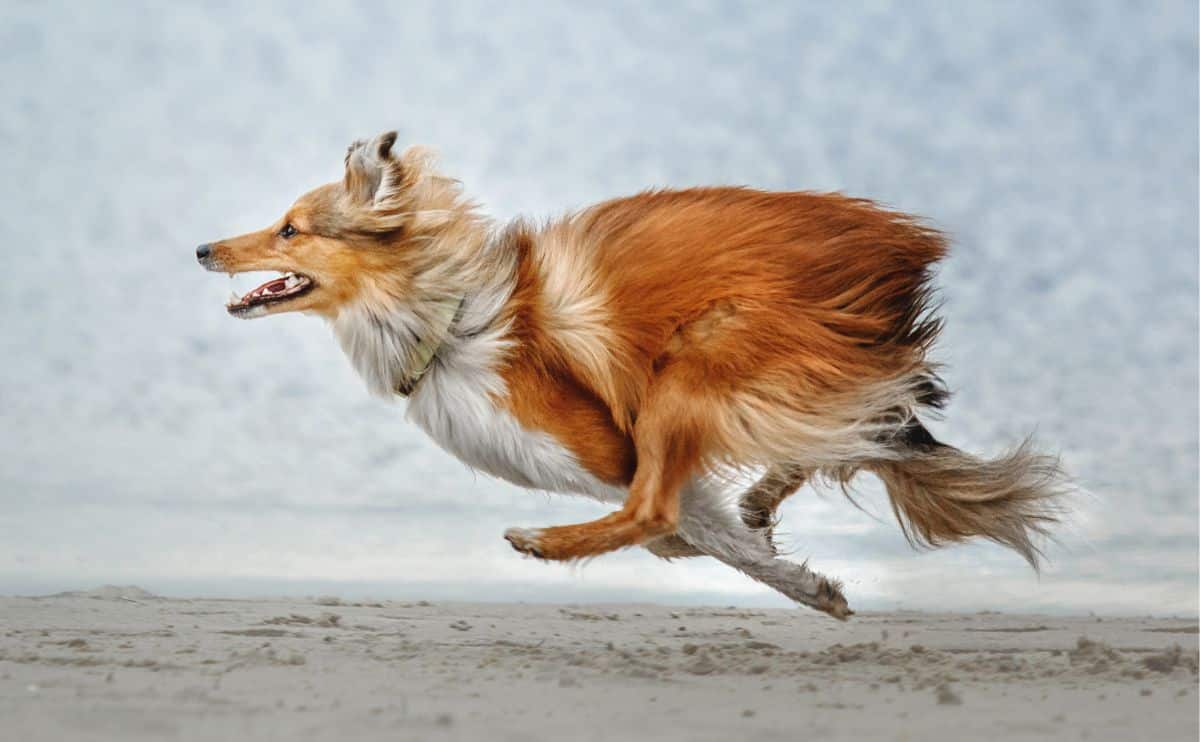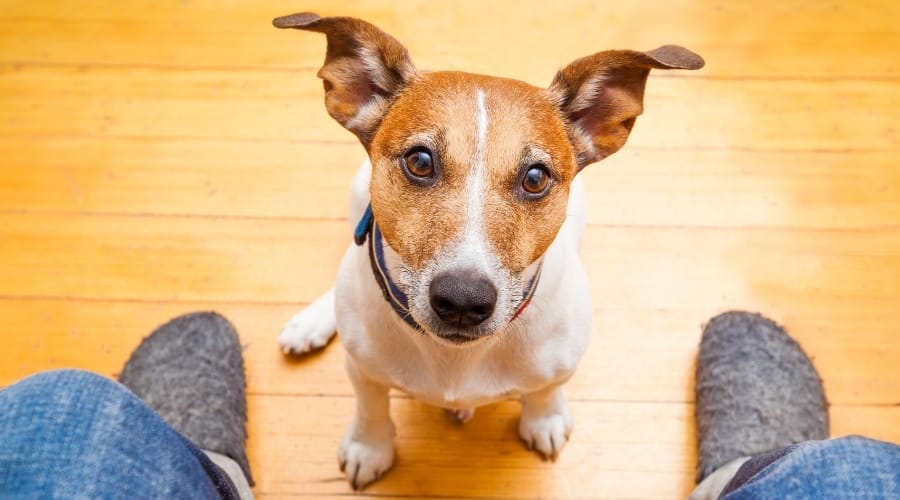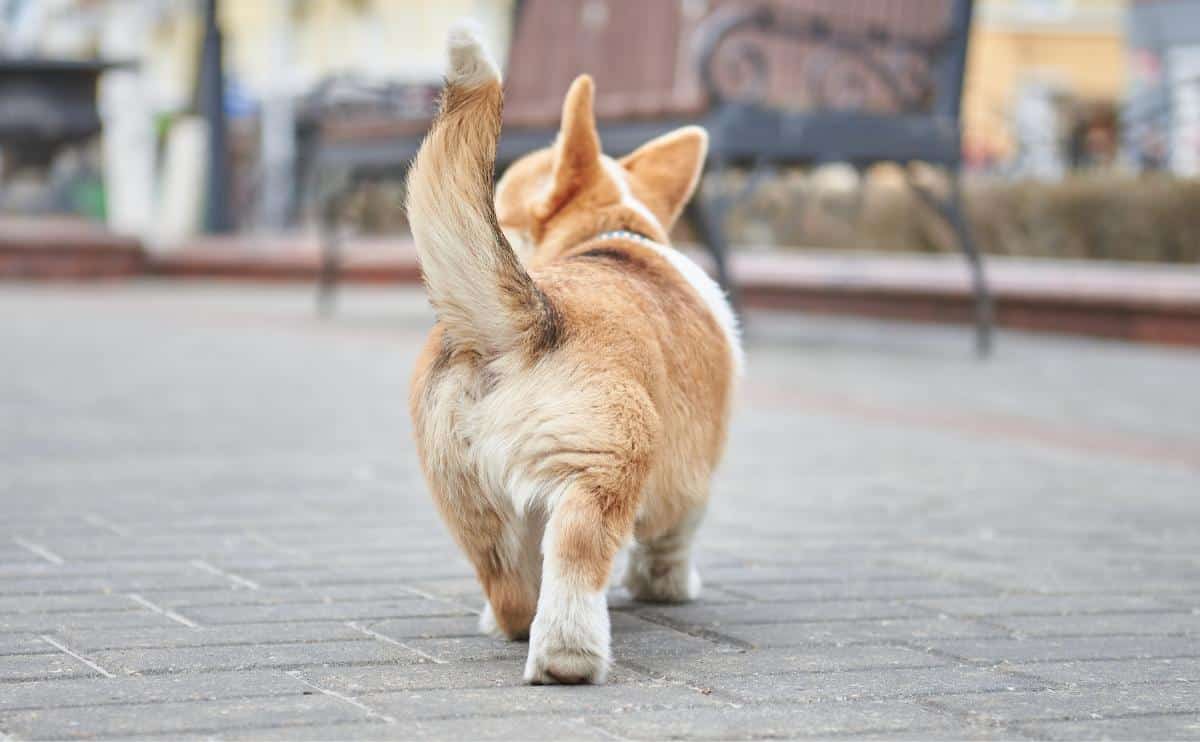When She Makes The First Move: Why Does My Female Dog Hump My Male Dog?
When you purchase through links on our site, we may earn a commission. Here’s how it works.
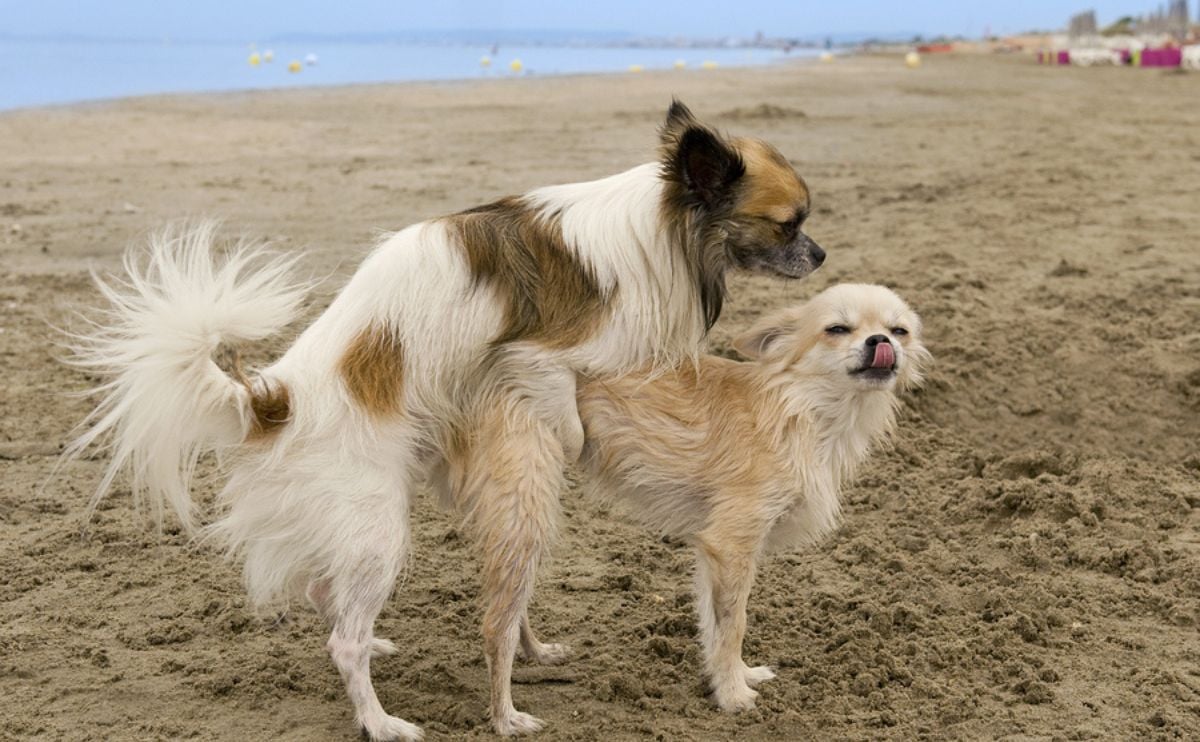
Friends and dog lovers, it’s time we tackled one of life’s more… delicate canine conundrums: female dogs humping male dogs. Let’s not blush—we’re all adults here, right? If not, let’s at least try to keep it mature while discussing why our furry friends sometimes engage in the bump n’ grind, whether it be on other dogs, your legs, the couch—or even the occasional throw pillow. Who knows? You might even get a laugh along the way.
Table of Contents
Why Do Dogs Hump?
Here’s the deal. Some dogs never hump. Others go all out like they’re trying to win “Dancing With the Dogs.” Whether they’re fixed or not, both male and female dogs can channel their inner party animal and break out the hind-legged hokey-pokey.
They may do it for different reasons, but they’re equal-opportunity offenders. This isn’t a one-size-fits-all behavior. So, if you’re confused about the scenario of “female dog humping male dog,” know that it can be about dominance, play, stress, hormones, or simply, “Hey, this feels pretty great!”

7 Reasons Female Dogs Hump
Humping, though awkward and sometimes embarrassing, is often a normal behavior activity for a dog. It can be part of play, a sexual behavior, or be connected to a medical issue.
1. Showing Dominance
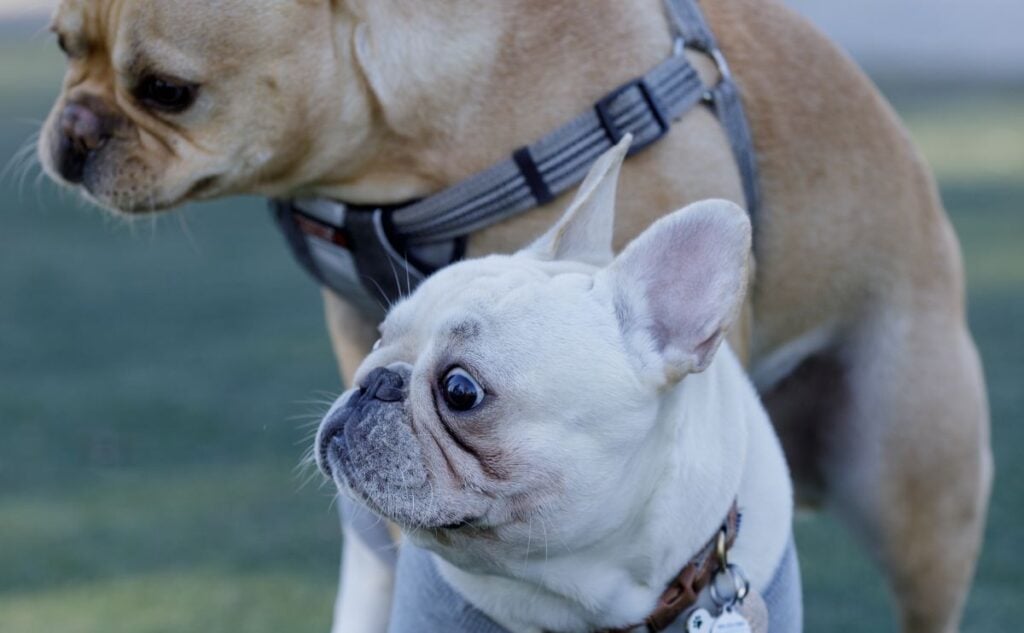
Ah, dominance—the canine version of calling the shots. Sometimes humping isn’t about romance or reproduction; it’s about who’s boss. Female dogs, while often less dominant than males, can still assert themselves by hopping aboard another pup.
Think of it as your dog’s way of saying, “I’m the queen here, bow down.” She’s establishing her place in the pack hierarchy, a natural behavior for dogs who thrive in social structures. But let’s not confuse dominance humping with anything remotely sexual. This is all about power, not passion. Your pup may even try asserting control over humans by mounting legs or feet—a clear signal she’s testing the boundaries of her pack (that’s you).
While this behavior may seem harmless, it’s best to intervene to avoid misunderstandings or conflicts with other dogs. Over time, unaddressed dominance humping could escalate into more aggressive behaviors.
Pro tip: Consistent training and redirection can save your household hierarchy—and your guest list. Use clear commands like “Off” and reinforce positive behaviors with treats and praise. Make sure every member of your household follows the same rules so your dog doesn’t receive mixed signals.
2. They’re Just Playing
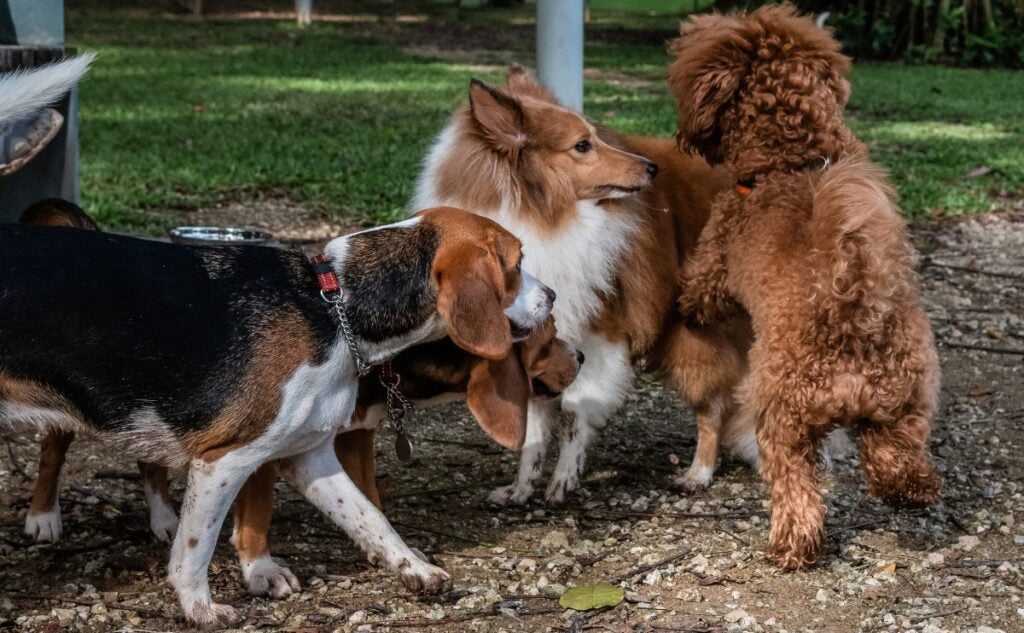
Believe it or not, humping is sometimes as innocent as a game of tug-of-war. Dogs can mount each other during play without a single thought of puppy love. According to the UC Davis School of Veterinary Medicine, humping can be part of normal play behavior without being purposefully sexual. Awkward for humans? Yes. Awkward for dogs? Not in the slightest.
Picture this: Your dog sees another pup bow in invitation for play. Instead of responding with a friendly bounce, she mounts them like she’s auditioning for a role in “Canine Fifty Shades of Grey.” It’s often just hyperarousal—a fancy term for “overexcited” in doggy language.
This behavior is particularly common in under-socialized dogs. While a well-socialized pup understands play bows, tailing wagging, and other canine cues, a dog with limited social experience might misinterpret the signals. What starts as a friendly invitation to play can quickly turn into an awkward mounting session. For these pups, play can be overwhelming, and humping becomes their go-to stress reliever.
In multi-dog households, you might notice your female dog humping your male dog during particularly rowdy play sessions. Think of it as a way for your dog to channel that extra energy or excitement. However, it’s essential to monitor these interactions closely. Even the most patient playmate might get fed up with being used as a climbing post, leading to growls, snaps, or even bites.
To curb this behavior, intervene before things escalate. Redirect your dog to a toy or engage them in a game of fetch to release some of that pent-up energy. Over time, consistent redirection and positive reinforcement can teach your pup to find more appropriate ways to express their excitement.
And remember: Playtime is meant to be fun for everyone—two-legged and four-legged friends alike! By keeping interactions positive and respectful, you’ll ensure your dog enjoys socializing without ruffling any fur.
3. Boredom Or Stress
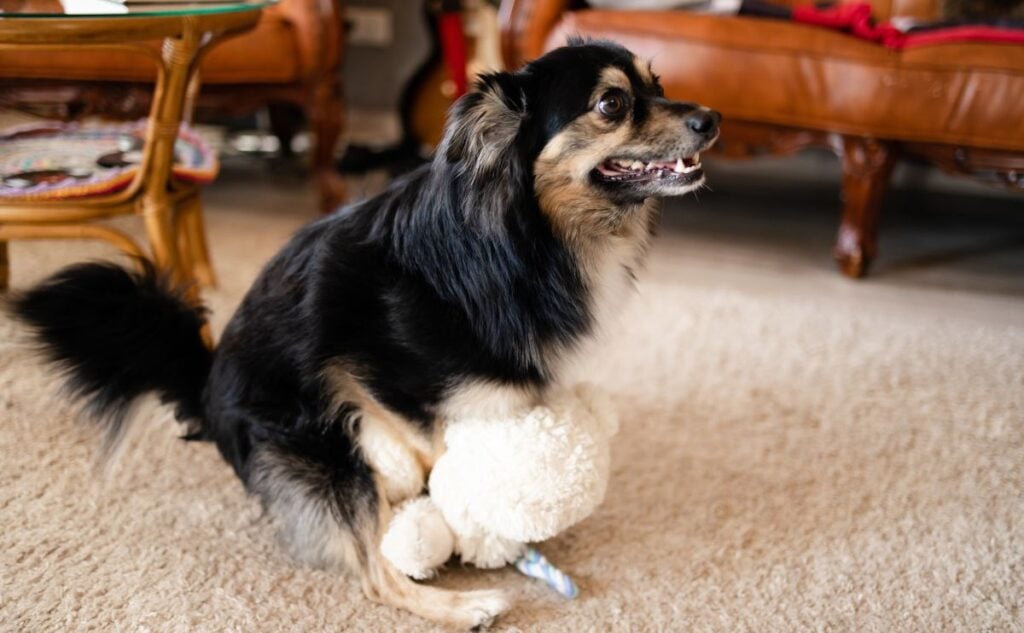
If your dog’s life were a soap opera, excessive humping might be the dramatic monologue. Dogs left alone, under-stimulated, or stressed can develop habits to pass the time or soothe their nerves. Some chew shoes; others write in their journals. Your dog? She mounts the nearest available object—or dog.
Boredom is often the culprit for humping behaviors. Dogs need both mental and physical stimulation to stay happy and balanced. Without it, they’ll invent their own entertainment, which might involve turning your couch cushion into their dance partner. Regular exercise, puzzle toys, and interactive play can work wonders in keeping your pup engaged and less likely to hump.
Stress, on the other hand, can trigger humping as a form of self-soothing. Separation anxiety, changes in routine, or even tension in the household can lead your dog to act out in unexpected ways. For example, if you’ve recently moved or introduced a new pet, your dog might resort to humping to cope with the upheaval.
To help, provide a calming environment and stick to a consistent routine. Consider tools like pheromone diffusers or anxiety wraps, and don’t hesitate to seek advice from a vet or trainer if the behavior persists. Remember, a tired and happy dog is far less likely to turn to humping as an outlet.
4. Hormones Or Being In Heat
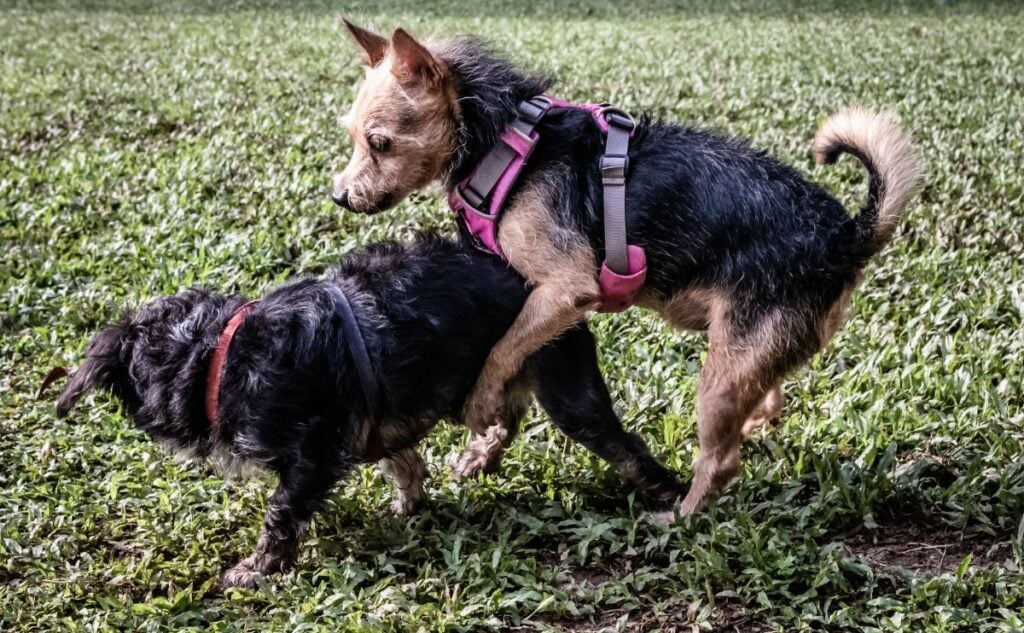
Good old hormones—the cause of so many questionable decisions in life. If your female dog isn’t spayed and is in heat, she’s likely dealing with some serious urges. Humping might be her way of saying, “Someone put on ‘Let’s Get It On’ because I’m feeling frisky.”
When female dogs are in heat, their bodies are flooded with reproductive hormones that drive instinctual behaviors, including humping. This behavior is typically directed toward other dogs, but it’s not uncommon for a hormonal dog to target furniture, toys, or even their human companions. It’s nature at work, but that doesn’t make it any less awkward.
Spaying your dog is the best solution if you’re not planning on breeding her. Not only does it eliminate heat cycles and reduce the likelihood of humping, but it also lowers the risk of certain cancers and other health issues. Plus, it spares you the added stress of managing her behavior during those hormone-driven episodes.
Keep in mind that even spayed dogs may hump occasionally. While the behavior usually decreases post-surgery, it doesn’t disappear entirely. Training and redirection remain important tools for managing any residual tendencies.
5. They’re Trying To Get Your Attention
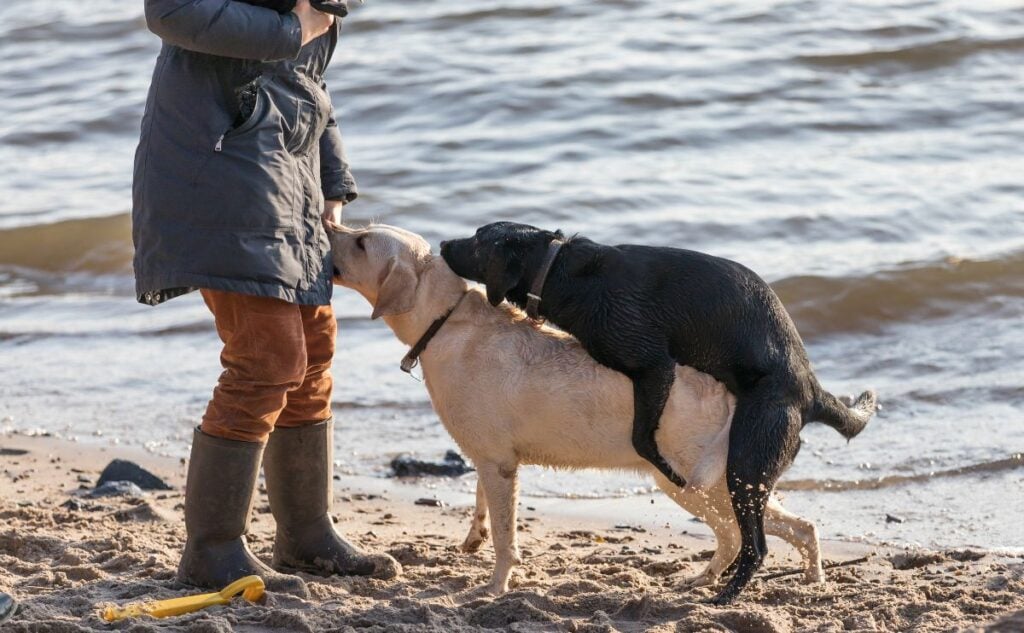
Dogs are smart. They know that humping often triggers a reaction. And whether you’re laughing, scolding, or hiding your face in embarrassment, your reaction fuels the behavior.
Attention-seeking humping is a classic case of “any attention is good attention.” If your dog realizes that mounting the couch or another dog gets you to look their way, they’ll keep doing it. This behavior is particularly common in dogs who feel neglected or crave more interaction with their owners.
To address this, it’s essential to stay calm and avoid making a big deal out of the behavior. Scolding your dog or laughing at their antics might accidentally reinforce the very thing you’re trying to stop. Instead, redirect their energy to a more appropriate activity. Offer a toy, initiate playtime, or guide them through a training exercise. Positive reinforcement works wonders in these situations.
Over time, your dog will learn that good behavior earns your attention while humping does not. Consistency is key—ensure everyone in your household follows the same approach to avoid sending mixed signals.
Our Personal Experience With Dogs Humping For Attention
When guests come over, our 35-pound terrier gets super excited. She grabs a favorite toy to show the guest and sometimes even resorts to “humping” our other dog’s backend to further demonstrate excitement and enthusiasm for playing with this new friend. It can be a little embarrassing, but now that we understand she’s just looking for attention from the guest, we are often able to prevent it from happening by throwing a ball or toy to distract her right away.
– Michelle Schenker, rescue pup parent
6. It Feels Good
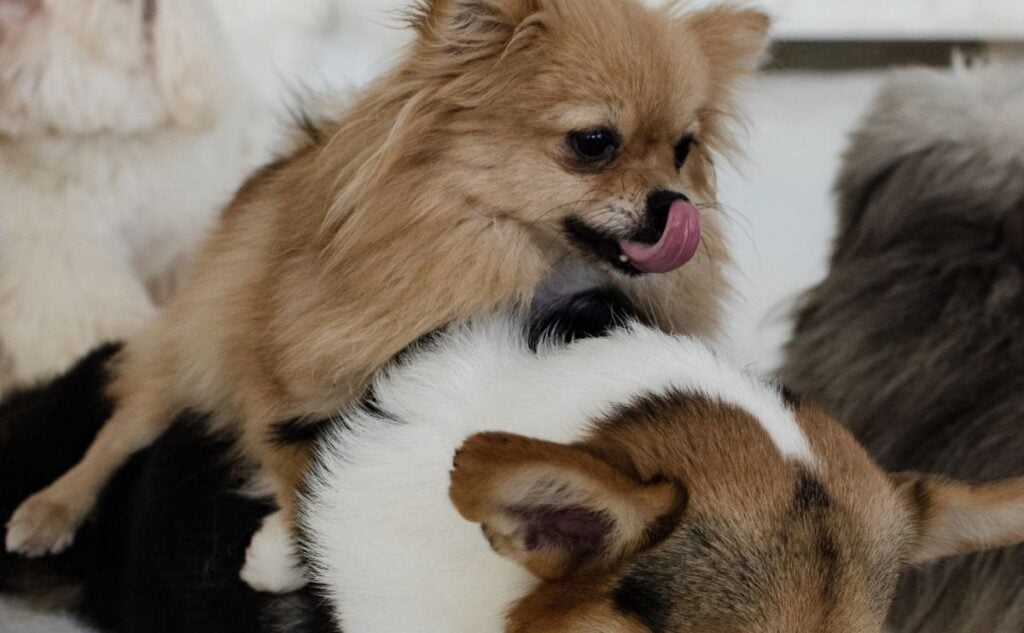
Sometimes, it’s not about dominance, stress, or even attention. It’s just that simple: humping feels nice. Your dog might be scratching an itch, soothing discomfort, or, well, enjoying herself.
Just like humans find comfort in repetitive actions, dogs may find the physical sensation of humping pleasurable. This behavior is especially common in young dogs who are still exploring their bodies and learning what feels good. While it’s a natural part of canine development, excessive humping could indicate an underlying issue.
Skin allergies, irritation, or even a sore spot can lead your dog to hump as a way of alleviating discomfort. If you notice other signs of distress, such as licking, redness, or swelling, it’s time to consult your vet. Identifying and treating the root cause will help curb the behavior and ensure your pup stays comfortable.
If the humping is occasional and doesn’t bother anyone, it’s usually harmless. However, setting boundaries and encouraging alternative behaviors is always a good idea to prevent it from becoming a habit.
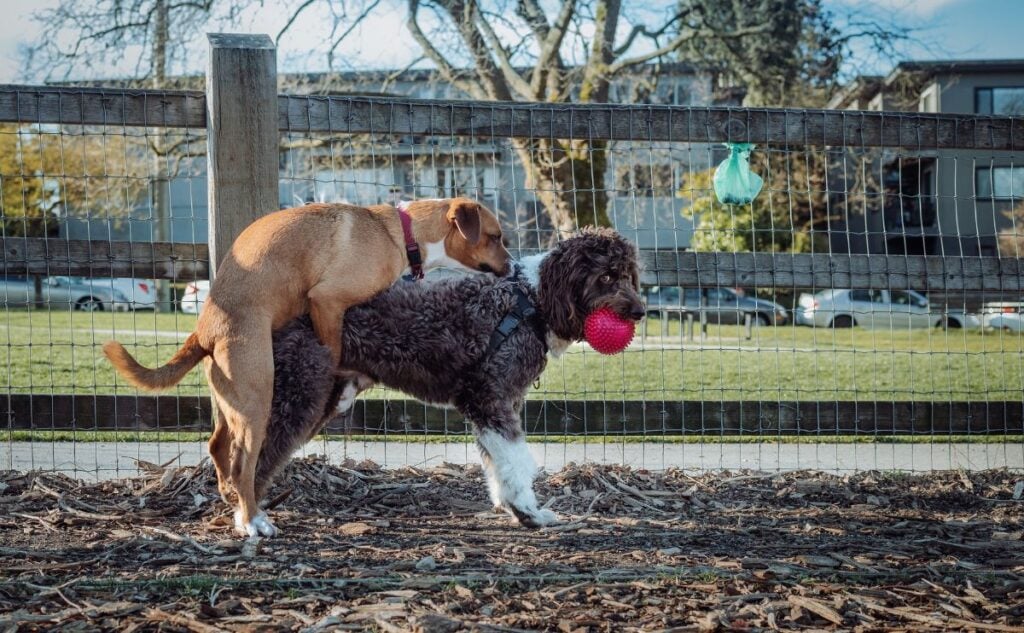
7. Injury Or Illness
Finally, let’s not overlook medical causes. A female dog might hump due to discomfort from urinary tract infections, skin allergies, or even parasites. If the behavior seems excessive or out of character, it’s time for a vet visit. After all, your pup deserves to feel her best—without the need to hump her way there.
Medical issues can manifest in subtle ways, and humping might be your dog’s way of signaling that something isn’t quite right. For example, a urinary tract infection can cause irritation, leading to behaviors like excessive licking or mounting. Similarly, hormonal changes (like those in pregnant dogs) or false pregnancies can trigger unexplained humping.
If your dog’s humping behavior is accompanied by other symptoms, such as changes in appetite, lethargy, or unusual urination habits, don’t delay in seeking veterinary care. Early diagnosis and treatment can prevent minor issues from becoming major health concerns.
Why Does My Female Dog Hump My Male Dog?
It might feel strange to see your female dog humping your male dog, especially if they’re siblings, but rest assured, this behavior is more about dog instincts and communication than anything familial. Dogs don’t have the same social constructs we do when it comes to family relationships. Humping between “siblings” is more tied to playfulness, excitement, or testing social boundaries.
When your female dog humps your male dog, it’s likely a display of playfulness, excitement, or social interaction. Dogs use humping as a way to burn off energy, assert dominance, or express overstimulation. Sometimes, it may also be a way for her to initiate play or test boundaries. If your male dog seems unbothered, it’s usually harmless. However, if the behavior becomes excessive or causes tension, consider redirecting her attention with toys, commands, or structured play to prevent it from becoming a habit.
What To Do When Every Day Is Hump Day
So, you don’t want your Great Dane getting her groove back with your leather sofa or that bossy Chiweenie at the dog park? Totally understandable. We’re here to help you steer your four-legged friend toward better manners while keeping your sanity intact. Here’s how to curb the urge and manage your pup’s amorous adventures:
Rule Out Injury Or Infection
First things first: Make sure your dog’s humping isn’t due to something medical. A urinary tract infection, skin irritation, or even pain in their hindquarters can sometimes lead to humping as a way of self-soothing. When in doubt, check in with your vet. It is better to overreact than to have your dog’s dance moves turn out to be a cry for help.
Relieve Boredom Or Stress
Sometimes, humping is less about hormones and more about having too much time on their paws. If your pup is under-stimulated or anxious, they might vent their frustrations on your furniture, leg, or playmates. Increase their exercise and playtime to burn off excess energy. A tired dog is a well-behaved dog. Plus, who can hump when they’re too busy snoozing?
Redirect And Reinforce
Caught your dog mid-thrust? Don’t panic—this is your moment to shine as a calm, collected pet parent. Gently but firmly redirect their attention to something more appropriate. A squeaky toy, a tasty treat, or a request to perform a trick can shift their focus. When they engage in the alternative activity, lay on the praise like they’ve just solved world peace. Dogs love a good ego boost.
Don’t Let It Escalate
Sure, the first few seconds of doggy humping might be good for a laugh, but the comedy can quickly turn into chaos. The dog on the receiving end might not appreciate the attention and could respond with an angry growl or a snap. To avoid potential drama, intervene early. Be proactive and prevent your dog from turning the dog park into their personal rom-com set.
Stay Consistent
Managing humping behavior isn’t a one-and-done deal. Consistency is key. Keep reinforcing positive behavior and redirecting inappropriate mounting every time it happens. It’s a process, but with patience (and maybe a sense of humor), your pup will learn the ropes—and leave your couch cushions and fellow dog park patrons in peace.
Remember, humping is normal dog behavior. But with these tips, you can help your furry friend channel their energy in less awkward ways. Now go forth and reclaim your sofa!
When To Get Professional Help
If your dog simply will not stop and her behavior is interfering with normal dog life, consult a canine behaviorist. Check out this article about finding a Certified Applied Animal Behaviorist or a board-certified veterinary behaviorist. If you can’t find a behaviorist in your area, seek a Certified Professional Dog Trainer with professional or academic training and experience treating compulsive behaviors (not all dog trainers have this). You might also consider online dog training courses.
Frequently Asked Questions

We’ve received lots of questions about why female dogs hump, so we’ve answered the top queries here. Don’t see yours? Ask us in the comments!
Is It Normal For Female Dogs To Hump?
Absolutely! Humping isn’t just a male dog behavior—it’s perfectly normal for female dogs too. It’s often a way for dogs of any gender to express excitement, stress, playfulness, or even boredom. It’s not always about dominance or mating instincts.
Why Does My Spayed Female Dog Still Hump?
Spaying removes the reproductive hormones but doesn’t eliminate all humping behavior. Dogs might hump as a form of play, an outlet for pent-up energy, or a way to self-soothe if they’re anxious or overstimulated. It’s not necessarily related to their reproductive status.
Should I Be Worried If My Dog Humps Excessively?
Occasional humping is fine, but if it becomes excessive, it could indicate an underlying issue like boredom, stress, or even a medical condition such as a urinary tract infection or skin irritation. If you’re concerned, consult your veterinarian.
My Dog Only Humps Her Favorite Toy—Should I Let Her?
As long as it’s not obsessive or harmful, it’s generally fine for dogs to hump a toy occasionally. It’s a harmless outlet for their energy or excitement. If it bothers you, gently redirect her to another activity.
Proper Dog Park Etiquette
No one wants to be humped unexpectedly at the dog park, four or two-legged folks alike. To give you a place to start, we cover proper dog park etiquette for pups and their parents. If your dog bites someone or gets bitten, you or another owner may face liability or even legal consequences. For this reason, proper training and prevention of bad behavior is essential.
Why Trust Canine Journal?
Danielle is a dedicated pet owner with over 30 years of experience. She has raised many different dogs, from five-pound Chihuahuas to 85-pound Labrador Retrievers. Danielle is a dedicated writer and researcher who spends countless hours reviewing the latest studies and data in pet care, health, behavior, and products.
